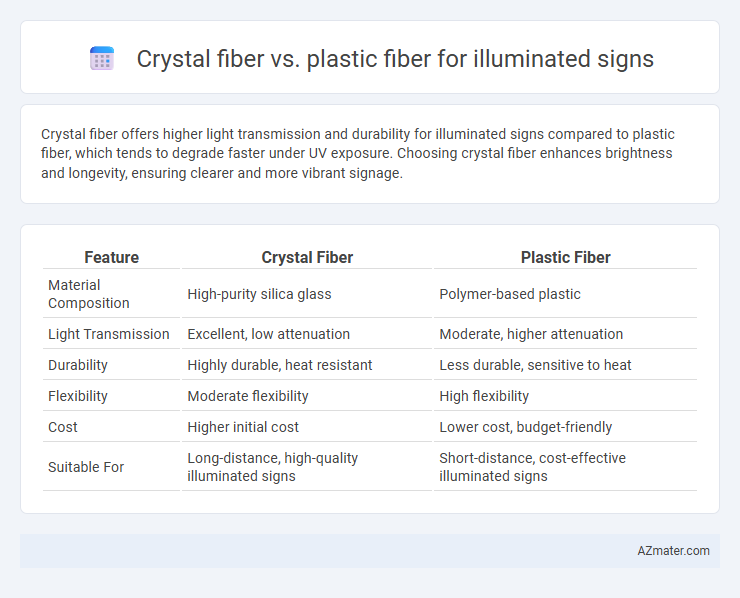Crystal fiber offers higher light transmission and durability for illuminated signs compared to plastic fiber, which tends to degrade faster under UV exposure. Choosing crystal fiber enhances brightness and longevity, ensuring clearer and more vibrant signage.
Table of Comparison
| Feature | Crystal Fiber | Plastic Fiber |
|---|---|---|
| Material Composition | High-purity silica glass | Polymer-based plastic |
| Light Transmission | Excellent, low attenuation | Moderate, higher attenuation |
| Durability | Highly durable, heat resistant | Less durable, sensitive to heat |
| Flexibility | Moderate flexibility | High flexibility |
| Cost | Higher initial cost | Lower cost, budget-friendly |
| Suitable For | Long-distance, high-quality illuminated signs | Short-distance, cost-effective illuminated signs |
Introduction to Illuminated Signage Technologies
Illuminated signage technologies utilize both crystal fiber and plastic fiber, each offering distinct advantages in light transmission and durability. Crystal fiber provides exceptional clarity and brightness due to its high purity silica composition, making it ideal for premium signage requiring vivid illumination. Plastic fiber, characterized by its flexibility and cost-effectiveness, is commonly used in applications where lightweight and impact resistance are essential without compromising visibility.
Overview of Crystal Fiber in Signage
Crystal fiber used in illuminated signage offers superior light transmission and durability compared to plastic fiber, resulting in brighter and more uniform illumination. Its enhanced clarity and resistance to yellowing ensure long-lasting visual impact, making it ideal for high-quality, attention-grabbing signs. Crystal fiber's ability to maintain consistent light dispersion under various environmental conditions positions it as a premium choice for outdoor and indoor signage applications.
Overview of Plastic Fiber in Signage
Plastic fiber, commonly used in illuminated signage, offers flexibility, durability, and cost-effectiveness compared to crystal fiber. Its lightweight nature and resistance to environmental factors make it ideal for outdoor or dynamic signage applications. Enhanced light transmission and easy installation further position plastic fiber as a preferred choice for vibrant, energy-efficient signage solutions.
Optical Performance Comparison
Crystal fiber offers superior optical clarity and higher light transmission efficiency compared to plastic fiber, resulting in brighter and more uniform illumination for signs. Its low attenuation rate minimizes signal loss over longer distances, enhancing overall visibility and color vibrancy. Plastic fiber, while more flexible and cost-effective, typically exhibits higher light scattering and degradation, reducing optical performance in illuminated signage applications.
Durability and Lifespan Analysis
Crystal fiber offers superior durability and longer lifespan compared to plastic fiber in illuminated signs due to its higher resistance to UV radiation, moisture, and thermal fluctuations. Plastic fiber tends to degrade faster under environmental stress, leading to potential discoloration and brittleness within 3 to 5 years, whereas crystal fiber can maintain optical clarity and structural integrity for over a decade. Investing in crystal fiber reduces maintenance frequency and replacement costs, enhancing the overall longevity and performance of signage installations.
Flexibility and Design Versatility
Crystal fiber offers superior flexibility compared to plastic fiber, allowing for intricate and dynamic shapes in illuminated sign designs. Its higher tensile strength and resistance to bending make it ideal for applications requiring sharp curves and detailed patterns. Plastic fiber, while more cost-effective, tends to be less flexible and limits design versatility due to its rigidity and susceptibility to breakage under stress.
Cost Comparison: Crystal vs Plastic Fiber
Crystal fiber typically incurs higher initial costs due to its superior light transmission and durability, making it a premium choice for illuminated signs. Plastic fiber offers a more budget-friendly option with lower material and installation expenses but may require more frequent replacements due to reduced longevity. When comparing total cost of ownership, plastic fiber can be economical for short-term projects, whereas crystal fiber proves cost-effective over extended periods because of minimal maintenance and enhanced performance.
Maintenance Requirements and Challenges
Crystal fiber in illuminated signs offers superior durability with minimal maintenance due to its resistance to yellowing and environmental damage, ensuring long-term clarity and brightness. Plastic fiber, while more flexible and cost-effective, tends to degrade faster under UV exposure and requires frequent cleaning and eventual replacement to maintain optimal illumination. Maintenance challenges for plastic fiber include susceptibility to cracking and discoloration, increasing overall upkeep costs compared to the more robust crystal fiber options.
Environmental Impact and Sustainability
Crystal fiber used in illuminated signs offers enhanced durability and recyclability, significantly reducing environmental waste compared to plastic fiber options. Plastic fiber typically involves petroleum-based materials, leading to higher carbon emissions during production and limited biodegradability, which raises concerns about long-term environmental impact. Opting for crystal fiber not only promotes sustainability through longer product life cycles but also supports eco-friendly disposal practices, aligning with green building and advertising standards.
Choosing the Right Fiber for Illuminated Signs
Crystal fiber offers superior light transmission and durability compared to plastic fiber, making it ideal for high-performance illuminated signs requiring vibrant and consistent illumination. Plastic fiber provides cost-effective flexibility and ease of installation, suitable for shorter runs or budget-conscious projects with moderate lighting needs. Selecting the right fiber depends on factors like desired brightness, environmental exposure, and long-term maintenance costs to ensure optimal sign visibility and longevity.

Infographic: Crystal fiber vs Plastic fiber for Illuminated sign
 azmater.com
azmater.com